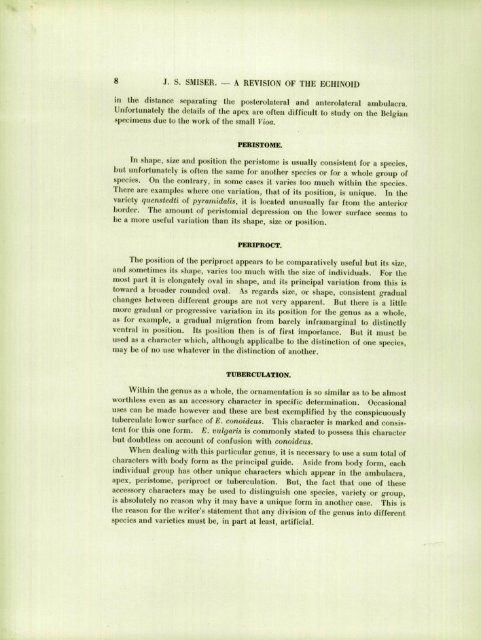ECIIINOID GENUS ECHINOCOIÎYS
ECIIINOID GENUS ECHINOCOIÎYS
ECIIINOID GENUS ECHINOCOIÎYS
Create successful ePaper yourself
Turn your PDF publications into a flip-book with our unique Google optimized e-Paper software.
8<br />
J. S. SMISER. — A REVISION OF THE ECHINOID<br />
in the distance separating the posterolateral and anterolateral ambulacra<br />
Unfortunately the details of the apex are often difficult to study on the Belgian<br />
specimens due to the work of the small Vioa.<br />
PERISTOME.<br />
In shape, size and position the peristome is usually consistent for a species,<br />
but unfortunately is often the same for another species or for a whole group of<br />
species. On the contrary, in some cases it varies too much within tluTspecies.<br />
There are examples where one variation, that of its position, is unique In the<br />
variety quenstedti of pyramidalis, it is located unusually far from the anterior<br />
border. The amount of peristomial depression on the lower surface seems to<br />
be a more useful variation than its shape, size or position.<br />
PERIPROCT.<br />
The position of the pcriproct appears to be comparatively useful but il« size<br />
and sometimes its shape, varies too much with the size of individuals. For tInmost<br />
part it is elongately oval in shape, and its principal variation from this is<br />
toward a broader rounded oval. As regards size, or shape, consistent gradual<br />
changes between different groups are not very apparent, But there is a little<br />
more gradual or progressive variation in its position for the genus as a whole<br />
as for example, a gradual migration from barely inframarginal to distinctly<br />
ventral in position. Its position then is of first importance. But it must be<br />
used as a character which, although applicalbe to the distinction of one species,<br />
may be of no use whatever in the distinction of another.<br />
TUBERCULATION.<br />
Within the genus as a whole, the ornamentation is so similar as to be almost<br />
worthless even as an accessory character in specific determination. Occasional<br />
uses can be made however and these are best exemplified by the conspicuously<br />
tubcrculatc lower surface of E. conoideas. This character is marked and consistent<br />
for this one form. E. vulgaris is commonly stated to possess this Character<br />
but doubtless on account of confusion with conoideus.<br />
When dealing with this particular genus, it is necessary to use a sum total of<br />
characters with body form as the principal guide. Aside from body form, each<br />
individual group has other unique characters which appear in the ambulacra<br />
apex, peristome, periproct or tuberculation. But, the fact that one of these<br />
accessory characters may be used to distinguish one species, variety or £*Tlip<br />
is absolutely no reason why it may have a unique form in another case. This is<br />
the reason for the writer's statement that any division of the genus into differed<br />
species and varieties must be, in part at least, artificial.

















